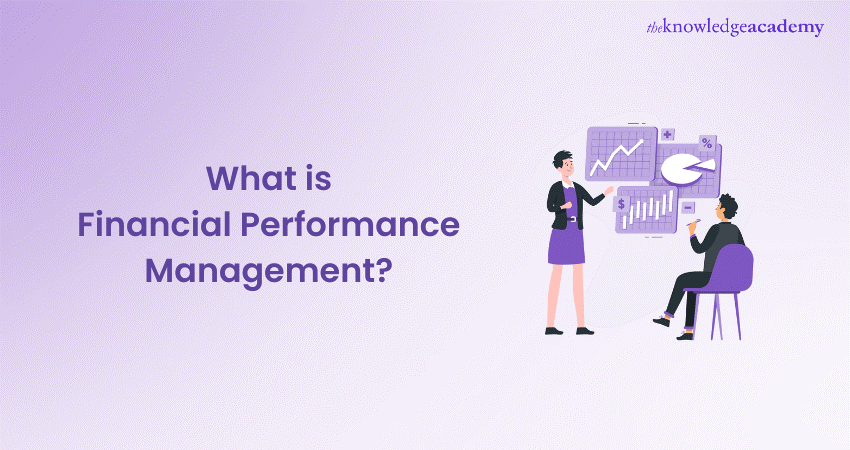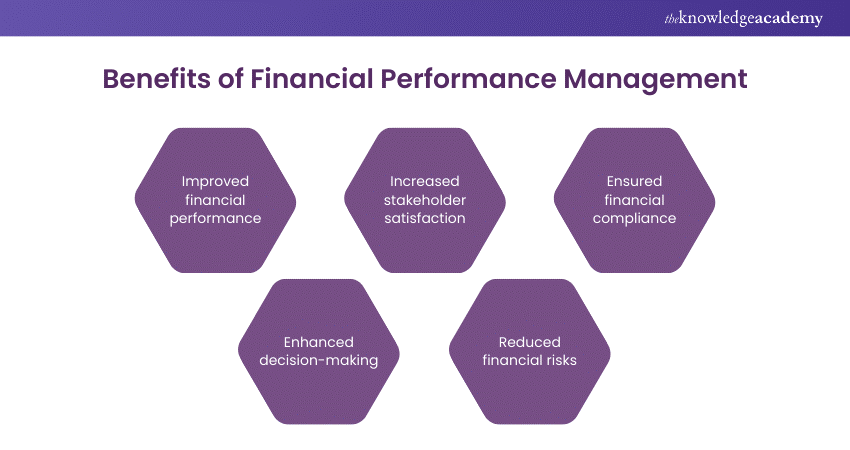We may not have the course you’re looking for. If you enquire or give us a call on 01344203999 and speak to our training experts, we may still be able to help with your training requirements.
Training Outcomes Within Your Budget!
We ensure quality, budget-alignment, and timely delivery by our expert instructors.

Financial Performance Management is a highly challenging and difficult job. It requires vision towards desired objectives, realistic assessment of the current operations, and change with a flexible and responding approach. It also contains voluminous data, many calculations, and reports which need accuracy, timeliness, and relevance. How then can the managers rise to this challenge to make sure their organsation accomplishes the financial goals? The answer is Financial Performance Management (FPM). Keep reading to know more.
Table of Contents:
1) What is Financial Performance Management?
2) What is Financial Performance Management software?
3) Process of Financial Performance Management
4) Benefits of Financial Performance Management
5) Conclusion
What is Financial Performance Management?
Financial Performance Management (FPM) is one of the leading-edge Performance Management method used by organisations to measure, analyse, and improve their financial performance. The main role of FPM is to support the managers in a way that they can align planning, forecasting economic results, reporting, and communication of performance with the goals and strategies. Besides, the available resource identification and mitigation of the firm's risks are involved.
FPM covers a number of Financial Management areas such as budgeting, forecasting, reporting, and planning, among many others, including risk management. FPM also helps in integrating the financial process with relevant technologies and tools, which help in automation, integration, and smooth processes with a view to insight and recommended execution.
What is Financial Performance Management software?
Financial Performance Management software supports and facilitates the FPM process. FPM software provides a platform for managers to access, manage, and analyse financial data from various sources, such as accounting systems, Enterprise Resource Planning (ERP) systems, Customer Relationship Management (CRM) systems, and other operational systems. FPM software also enables managers to create, modify, and share budgets, forecasts, reports, dashboards, and scenarios. FPM software can also perform advanced functions like variance analysis, what-if analysis, predictive analytics, and artificial intelligence (AI).
Learn to manage company finances with FinTech through our FinTech Course - register now!
Process of Financial Performance Management
The FPM process consists of several interrelated and iterative steps. The following are the main steps of the FPM process:
1) Goal setting and strategy alignment
The first step of the FPM process is to define and communicate the organisation's financial goals and strategies. These goals and methods should be aligned with the organisation's overall vision, mission, and values. They should all keep in mind the expectations and needs of the stakeholders.
The goals and strategies should also be SMART. Financial goals and strategies include revenue growth, profitability, market share, customer satisfaction, cost reduction, innovation, and sustainability.
2) Budgeting and forecasting
The second step of the FPM process is to plan and estimate the financial outcomes of the organisation based on the goals and strategies. This involves creating and updating budgets and forecasts that reflect the organisation's expected revenues, expenses, cash flows, assets, liabilities, and equity.
Budgets and projections should be based on realistic assumptions, historical data, and external factors, such as market trends, customer behaviour, and competitor actions. Budgets and forecasts should also be flexible and adaptable to changing conditions and scenarios.
3) Financial reporting
The third step of the FPM process is to collect, consolidate, and present the organisation's financial data in a standardised and consistent format. This involves preparing and publishing financial statements like the following:
a) Balance sheets
b) Cash flow statements
c) Income statements
d) Statements of changes in equity
Financial reporting also involves creating and distributing financial reports, such as profit and loss reports, budget vs. actual reports, variance reports, and performance reports. These reports provide you with detailed and relevant information on the organisation's financial performance.
4) Variance analysis
The fourth step of the FPM process is to compare and explain the differences between the organisation's actual and planned financial outcomes. This involves calculating and analysing the variances, such as revenue, expense, profit, and cash flow, that indicate the deviations from the budget and forecast. Variance analysis also involves identifying and evaluating the causes and effects of the variances, such as volume, price, efficiency, and quality. This explains the reasons and impacts of the deviations.
5) KPIs
The fifth step of the FPM process is to measure and monitor the organisation's financial performance using Key Performance Indicators (KPIs). KPIs are quantifiable metrics that reflect the progress and achievement of the organisation's financial goals and strategies.
KPIs should be aligned with the SMART criteria and the balanced scorecard framework. This would cover four perspectives: economic, customer, internal, and learning and growth. Financial KPIs include Return On Investment (ROI), net profit margin, revenue per employee, and working capital ratio.
6) Financial planning
The sixth step of the FPM process is to plan and execute the organisation's financial actions and decisions based on the economic data, analysis, and KPIs. This involves setting and prioritising the organisation's financial objectives, initiatives, and projects. Financial planning also involves allocating and managing the organisation's financial resources, such as capital, cash, and credit, as well as raising funds, investing funds, and controlling costs.
7) Risk management
The seventh step of the FPM process is to identify and mitigate the organisation's financial risks and uncertainties. This involves assessing and quantifying the potential threats and opportunities that could affect the organisation's financial performance. Potential threats and opportunities include market volatility, currency fluctuations, interest rate changes, inflation, regulation, and competition. Risk management also involves the following:
a) Developing and implementing risk response strategies and plans, such as hedging.
b) Diversifying, transferring.
c) Avoiding that could reduce or eliminate the negative impacts or increase or exploit the positive effects of the risks.
8) Performance improvement
The eighth step of the FPM process is to improve and optimise the organisation's financial performance. This involves finding and applying the best practices and benchmarks that could enhance the financial results and efficiency of the organisation.
Like Lean Management, Six Sigma, total quality management, and business process reengineering. Performance improvement also involves implementing and evaluating the corrective and preventive actions like root cause analysis and problem-solving. This could resolve or prevent the organisation's financial issues and challenges.
Learn how to make Financial Reports for international companies with our International Financial Reporting Standards Training - sign up now!
9) Compliance
This step involves adhering to financial regulations and requirements, such as taxation, auditing, reporting, and disclosure. These are imposed by authorities and agencies, such as the government, central banks, securities and exchange commissions, and accounting boards. Compliance also involves verifying and validating the accuracy, completeness, and reliability of the financial data and records that are produced by the organisation, like invoices, receipts, and vouchers.
10) Resource allocation
The next step is to allocate and distribute the organisation's financial resources among the various units, departments, and functions. This involves deciding and assigning financial responsibilities and authority. Resource allocation also involves balancing and reconciling the organisation's financial demands and supplies like revenues, expenses, assets, liabilities, and inflows and outflows.
11) Communication and collaboration
This involves sharing and exchanging financial information and insights. Communication and collaboration also involve soliciting and providing feedback and suggestions, and recommendations, on the financial performance and improvement of the organisation.
12) Technology and tools
Using and leveraging the technology and tools that support and enhance the FPM process makes the final step of Financial Performance Management. This involves selecting and implementing the appropriate software and hardware, like FPM software, ERP systems, CRM systems, accounting systems, and Cloud Computing, that enable and facilitate financial data collection, consolidation, presentation, analysis, and reporting. Technology and tools also involve adopting and utilising advanced features and functions, such as automation, integration, and Artificial Intelligence, as they provide financial insights and recommendations.
Benefits of Financial Performance Management
The FPM process offers various benefits to the organisation and its stakeholders. Some of the main benefits are as follows:

a) Improved financial performance: FPM helps the organisation achieve its economic goals and strategies by providing clear direction, a realistic plan, and a reliable feedback mechanism. It also allows the organisation to improve its financial results and efficiency by identifying and resolving challenges and applying best practices.
b) Enhanced decision-making: FPM helps the organisation make better and faster financial decisions by providing accurate, timely, and relevant economic data, analysis, and reports. FPM also helps the organisation make informed and proactive financial decisions by providing insights and recommendations based on predictive analytics and artificial intelligence.
c) Increased stakeholder satisfaction: This process helps the organisation increase the satisfaction and trust of its stakeholders by delivering consistent and transparent financial performance. FPM also helps the organisation meet and exceed the expectations and needs of its stakeholders by aligning its economic goals and strategies with their interests and values.
d) Reduced financial risks: FPM helps the organisation reduce and manage its financial risks and uncertainties. It assesses and quantifies potential threats and opportunities. It also develops and implements risk response strategies and plans. It also helps the organisation mitigate the negative impacts by using hedging, diversifying, transferring, and avoiding techniques.
e) Ensured financial compliance: FPM helps the organisation ensure and demonstrate its compliance with the relevant financial laws. FPM also helps the organisation avoid or minimise financial penalties and sanctions by complying with the financial authorities and agencies.
Conclusion
This blog discussed Financial Performance Management (FPM), a process of measuring, analysing, and improving an organisation's financial results. It discussed how FPM helps managers align their goals and strategies with the available resources to identify and mitigate risks. Further, we discussed the benefits it provides to the organisation and its stakeholders.
Master the skills of Financial Analysis with our Financial Analyst Training - sign up now!
Frequently Asked Questions

Financial accounting is a subset of FPM that focuses on recording, summarising, and reporting an organisation's financial transactions and events. FPM is a broader process that covers the entire financial management cycle, from goal setting and strategy alignment to continuous monitoring and improvement.

Some examples of FPM software are Oracle Hyperion, IBM Cognos, SAP Business Planning and Consolidation, Microsoft Dynamics, and Anaplan. This software provides various features and functions that support and facilitate the FPM process, such as data collection, consolidation, presentation, analysis, and reporting.

The Knowledge Academy takes global learning to new heights, offering over 30,000 online courses across 490+ locations in 220 countries. This expansive reach ensures accessibility and convenience for learners worldwide.
Alongside our diverse Online Course Catalogue, encompassing 17 major categories, we go the extra mile by providing a plethora of free educational Online Resources like News updates, Blogs, videos, webinars, and interview questions. Tailoring learning experiences further, professionals can maximise value with customisable Course Bundles of TKA.

The Knowledge Academy’s Knowledge Pass, a prepaid voucher, adds another layer of flexibility, allowing course bookings over a 12-month period. Join us on a journey where education knows no bounds.

The Knowledge Academy offers various Business Skills, including 8D Problem-Solving Training, Financial Management and Managing Behaviour Training Course, and Behaviour Management Training. These courses cater to different skill levels, providing comprehensive insights into Difference Between Neobanks and Fintech.
Our Business Skills Blogs cover a range of topics related to Leadership, offering valuable resources, best practices, and industry insights. Whether you are a beginner or looking to advance your Project Management skills, The Knowledge Academy's diverse courses and informative blogs have you covered.
Upcoming Business Skills Resources Batches & Dates
Date
 Introduction to Credit Control
Introduction to Credit Control
Fri 21st Jun 2024
Fri 30th Aug 2024
Fri 18th Oct 2024
Fri 20th Dec 2024







 Top Rated Course
Top Rated Course



 If you wish to make any changes to your course, please
If you wish to make any changes to your course, please


